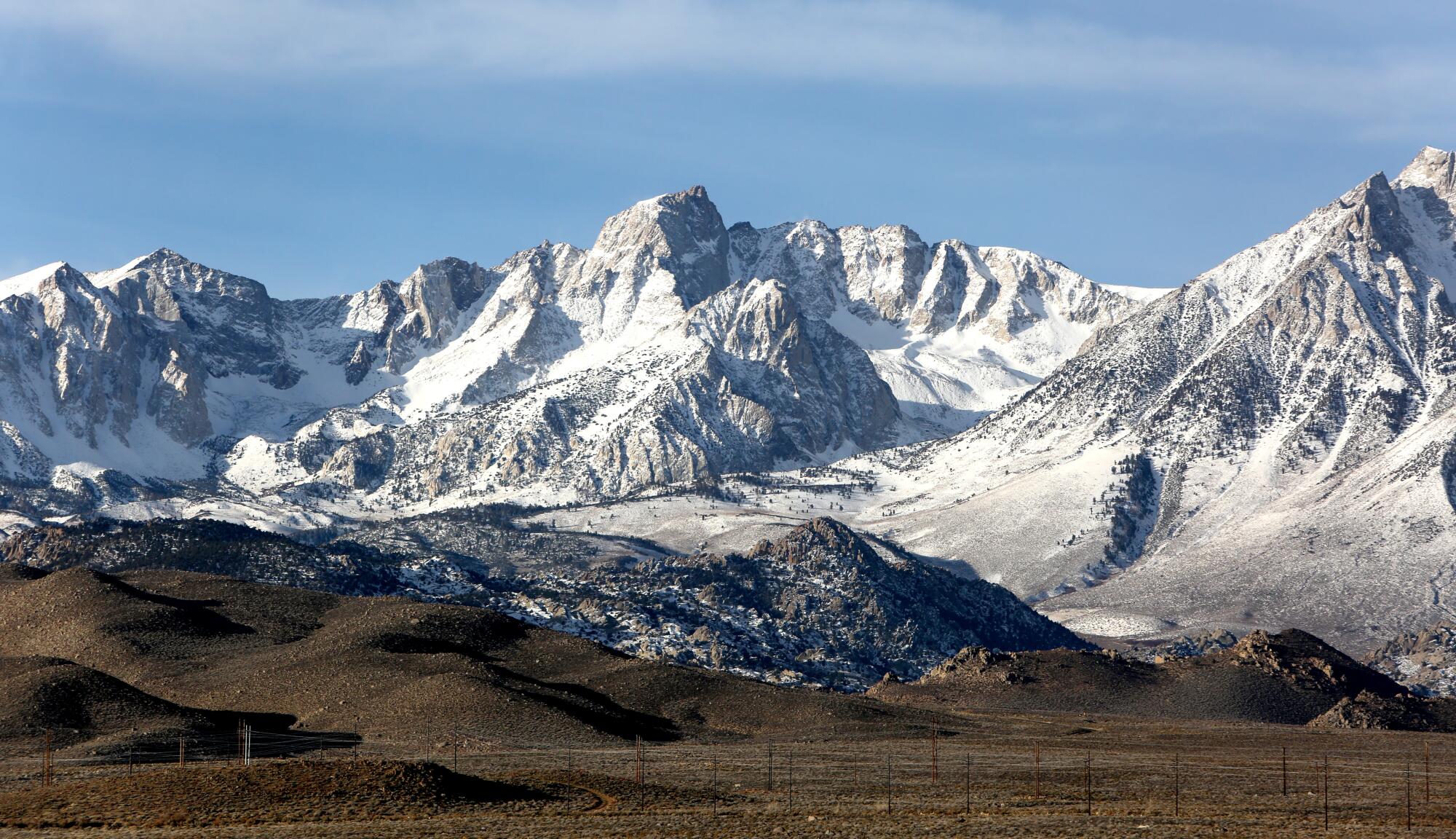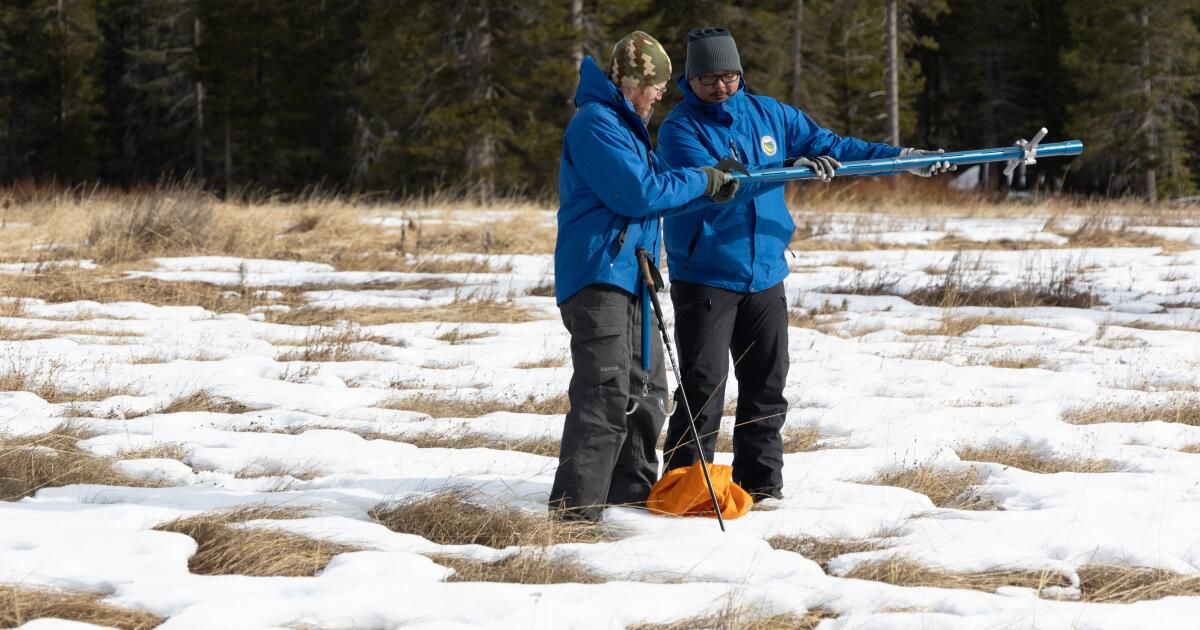On the heels of the planet's hottest year on record, new research out of Dartmouth has found that seasonal snow cover across the Northern Hemisphere has shrunk significantly over the past 40 years due to global warming, potentially putting millions of people at risk of worsening water instability.
Between 1981 and 2020, dozens of river basins have experienced a significant decline in snow water equivalent, or the amount of water contained in snow, due to human-caused climate change, according to a study published Wednesday in the Nature magazine.
The steepest declines (between 10% and 20% per decade) occurred in the southwestern and northeastern United States, as well as in central and eastern Europe.
That includes the Colorado River Basin, a key source of water for California and the Southwest, which declined to dangerous levels during the most recent drought. The basin has experienced a decline in spring snowpack of about 7% per decade over the past 40 years due to climate change, according to the study, or about 25% to 30%.
“What we're seeing is a longer-term aggregate pattern, and the question is: Is snow a reliable source of water availability for places like California in the future? And the answer, absolutely, is no, it is not,” said Justin Mankin, an associate professor of geography at Dartmouth College and one of the authors of the study.
Aggressive and impactful reporting on climate change, the environment, health and science.
Many snow-dependent watersheds are now on the edge of a threshold that researchers called the “snow loss cliff,” or a point at which marginal increases in temperature mean increasing snow losses in the future. The tipping point occurs when average winter temperatures in a basin exceed 17 degrees.
“Once you exceed that threshold, you start losing an increasing percentage of snow with each degree of warming,” said Alexander Gottlieb, lead author of the study and a doctoral student at Dartmouth. “It's like a snowball, for lack of a better word, of loss.”
In total, about 2.1 billion people live in snow-dependent watersheds that are at or just beyond the temperature threshold, the researchers said.
The findings have worrying implications for many places that rely on snowpack as a source of water, including California. The Golden State has long relied on spring and summer snowmelt from the Sierra Nevada to provide nearly a third of its supply.
The Sacramento River Basin has lost about 20% of its snowpack in the past 40 years due to climate change, while the San Joaquin River Basin has lost about 14%, Gottlieb said. However, he noted that there was slightly less statistical confidence around those findings than in the Colorado Basin.

A view of the snowy Eastern Sierra from Highway 168, just west of Bishop, California, this month.
(Raúl Roa / Los Angeles Times)
In fact, determining the influence of climate change on snow has been an elusive research question because there are many variables, such as fluctuating temperature and precipitation patterns and the presence of El Niño or La Niña in a given year. Measurement methods, such as satellites and remote sensing, have also changed and improved over the decades.
The researchers worked to standardize the disparate data to determine where there is a coherent signal of climate change. In total, they identified strong trends in 82 of 169 river basins in the Northern Hemisphere, including 31 river basins where they are “extremely confident” that the trends that have occurred in snow are attributable to global warming.
“We were able to provide the most compelling evidence to date that there is a really clear anthropogenic signal in all of our snowpack data,” Gottlieb said. “There is almost no chance that we would be observing these long-term trends without human interference in the climate system.”
Most of those basins are located at lower latitudes that are climatologically warmer, where even a degree of warming can push them over the so-called cliff. Basins further north are typically cold enough to withstand a degree or two of warming, and some actually experienced an expansion of snow cover due to increased precipitation, including parts of Alaska, Canada, and Central Asia. , the researchers said.
But in California and the Southwest, the trend is expected to worsen over time, with some areas projected to see 60% to 80% less snow by 2100, Gottlieb said.
“The train has left the station for regions such as the southwest and northeast of the United States,” he said. “By the end of the 21st century, we expect those places to be almost snow-free by the end of March.”
He referenced a 2021 study led by researchers at Lawrence Berkeley National Laboratory that found that winters with little or even no snow could become commonplace in California in as little as 35 years.
The study found a potential “cascade of implications” for the state beyond the loss of water supplies, including changes to soil, plants and wildlife, along with increased risk of flash flooding, debris flows and fires. forestry.
Erica Siirila-Woodburn, co-author of the Lawrence Berkeley study, said Gottlieb and Mankin's study is “an important step toward understanding why snow loss is occurring and how much snow loss we can expect in the future.”
Siirila-Woodburn said her findings are consistent with her own research and other snow loss projections, including the potential for precipitous falls in the Colorado River Basin.
“Taken together, these projections are bad news for already water-challenged regions, like California, which rely on snowpack for large fractions of their water supply,” he said. “In the 'snow loss cliff' analogy, we are actually floating over that cliff.”
The Dartmouth researchers added that snow loss could have economic implications for areas that rely on winter recreation and ski tourism. That includes the Hudson, Susquehanna, Delaware, Connecticut and Merrimack watersheds, which fuel the winter recreation economies in Vermont, New York, New Hampshire and other northeastern states.
“Ski resorts at lower elevations and latitudes have already been dealing with snow loss year after year,” Mankin said. “This will simply accelerate, making the business model unviable.”
It's a trend Californians are seeing in real time. Last week, Department of Water Resources officials conducted their first snow survey of the season and reported snow water content at just 25% of the average for the date.
The state anticipates a 10% reduction in water supply by 2040 and is seeking to make up for that shortfall in a variety of ways, including better hydrologic forecasting, improved reservoir operations, and new groundwater recharge projects to capture and store more water during the years. wet years. according to Andrew Reising, DWR water resources engineer.
“With decreasing snowpack projections, DWR will continue to capture as much water as possible while emphasizing that water conservation is now a way of life in California,” Reising said.
However, Mankin said there will still be years like 2023, when California experienced record snow.
“A year in which California has near-record or record snowpack is entirely consistent with the broader picture of global warming,” he said, noting that climate change is contributing to worsening swings between extreme precipitation and extreme dryness.
But long-term trends remain a lingering concern. Gottlieb noted that much of Western infrastructure is based on the notion of winter snow accumulation and its gradual melting in spring and summer.
“It's really going to take a lot of changes in the way we think about our water supply and management,” he said. “That paradigm will have to change, as the natural water storage reserve in the mountains during the winter will become increasingly unreliable.”












